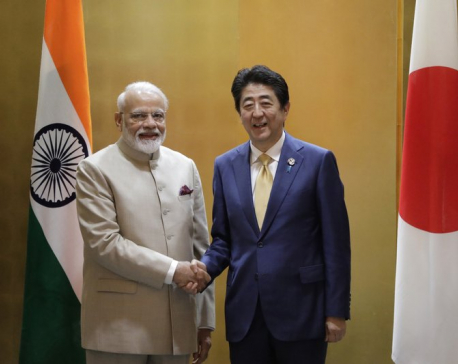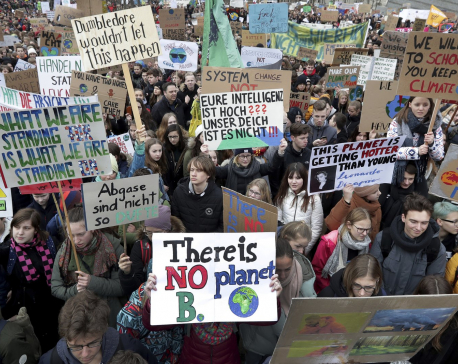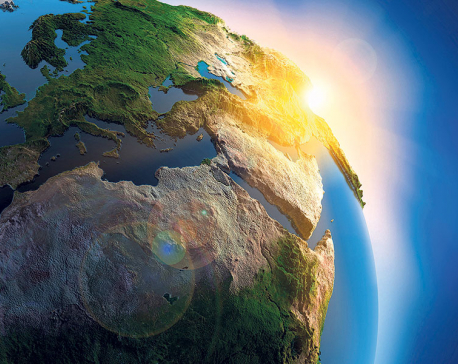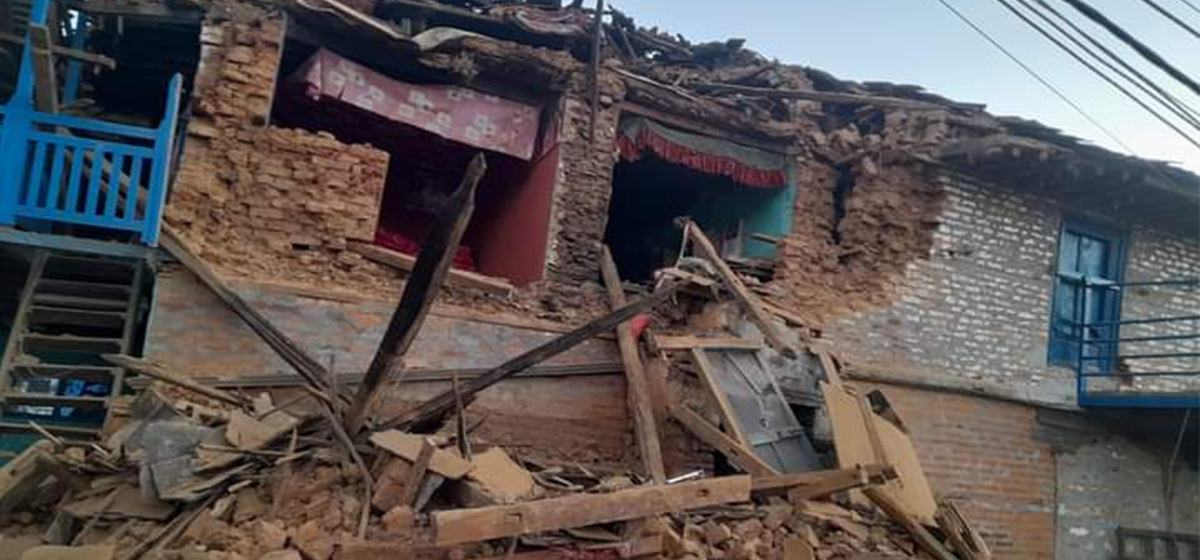
OR
Paris Agreement
Nepal’s climate targets woefully failing implementation test
Published On: January 29, 2020 07:50 AM NPT By: SHREE RAM SUBEDI
KATHMANDU, Jan 29: Under the Paris Agreement 2015, Nepal had promised to meet 14 targets related to climate change mitigation and adaptation in 2016. Four years on, the majority of the targets set under the Nationally Determined Contribution (NDC) have not been met thanks to weak implementation and the ambitious nature of the targets themselves. And this, experts warn, could raise a ‘question mark’ over Nepal’s commitment made at the global forum.
Nepal submitted NDC targets to the UN Framework Convention on Climate Change (UNFCCC) in October 2016, a year after the Paris Agreement on Climate change (2015) – which sought the parties concerned to submit their self-declared NDC goals by 2016. The NDC includes targets, strategies and policy goals from various national policies from various sectors. Of the 14 targets, four are about climate change adaptation, three about energy sources and supply, two about forestry sector, one about multi-sectoral mitigation, and four are related to the transport sector.
But progress has been made only under a few headings while the majority of the targets are still miles away. By 2020, the NDC aims to increase the share of electric vehicles in the country to 20 percent, but the current progress is less than one percent. The total number of registered vehicles in Nepal is 3.5 million and 78 percent of them are motorcycles alone. A 2018 estimate says that there were only 21,000 electric vehicles in Nepal, which is only 0.75 percent of the total registered vehicles.
The government levies only 10 percent customs duty on the import of electric vehicles while the same for non-electric ones is up to 240 percent. Also, the government has waived annual tax for electric vehicles and provided 50 percent discount on road maintenance tax.
“It is now a proven fact that government’s efforts alone would be insufficient to achieve the electric vehicle target,” said a mechanical engineer at the Department of Transport Management (DoTM) Mohan Bhattarai. “Good response from the private sector is crucial for meeting the target, but the private sector looks less interested for many reasons.”
“Infrastructure is a must to encourage more people to use electric vehicles. Currently, there are very few charging stations,” said President of Electric Vehicles Association of Nepal (EVAN) Umesh Shrestha. He argued that the government should give electric vehicles special priority to attract more investments in the sector.
Gyanendra Lal Pradhan, who is a National Council member of the Confederation of Nepalese Industries (CNI), suggests taking bold policy decisions to increase the number of electric vehicles. “All two-wheelers can be converted to electric vehicles immediately,’’ he said, adding, “The proposed electric rail network between Birgunj-Kathmandu could save millions that we spend on importing fossil fuel.”
The NDC seeks to increase the contribution of renewable energy to the energy mix to 20 percent, but the contribution so far is around 3 percent, according to Alternative Energy Promotion Center (AEPC). Nearly 69 percent of energy consumed in Nepal comes from traditional sources that include firewood, agricultural residues and dung cakes, according to the Economic Survey (2019). The remaining 28 percent energy need is met through commercial sources, which include grid electricity, petroleum products and coal.
In its 13th goal, NDC seeks to pilot a sub-national project on REDD+ to reduce about 14 million tons of CO2-equivalent by 2020 by addressing the drivers of deforestation and forest degradation. However, there is a delay in signing the Emissions Reduction Payment Agreement (ERPA) with the World Bank’s Forest Carbon Partnership Facility (FCPF), which would have opened the door for Nepal to sell carbon to the global market. The signing of the agreement, which was expected last December, has now been slated for April.
Drafted a few years ago, the Low Carbon Economic Development Strategy is still in limbo. The strategy seeks to promote economic development through low carbon emission with a particular focus on energy, agriculture and livestock, forests, industry, human settlements and wastes, transport and commercial sectors. Officials confide that there was a delay in its endorsement, as it was likely to have a negative impact on Nepal’s development push and economic growth.
Also, very few studies have been carried out to understand the loss and damage associated with climate change impact with the support from scientific and academic communities, which is also NDC’s major goal.
“We always have high energy and seriousness on setting the targets at the beginning, but we lack the same degree of seriousness in implementation,” Professor Amrit Man Nakarmi, affiliated with the Center for Energy Studies said, adding, “It’s the responsibility of the government to make conducive environment to realize these important goals.”
However, officials at the Ministry of Forest and Environment (MoFE) are optimistic, who argue that Nepal is at the forefront to realize the NDC targets.
“In 2015, when the Paris agreement was signed, the templates, duration and elements of NDC were not much clear, they were only explained in 2018 (COP 24) through a rule-book,” Dr Maheshwar Dhakal, the chief of Climate Change Division under the MoFE, said.
“We are currently working for enhanced NDC for Nepal, in accordance with the new governing structure of federal Nepal, Sustainable Development Goals (SDGs), Climate Policy-2076 BS and the 15th National Periodic Plan,” Dr Dhakal said.
“NDC is a multi-stakeholders commitment, and all concerned should work in tandem to realize the goals and safeguard Nepal’s international image,” said Dr Dhakal.
Nepal has made progress on increasing the total forest coverage to 44 percent, against the NDC target of 40 percent. Also, targets relating to the establishment of mini and micro-hydro, solar home systems, biogas, and improved stoves have already been achieved, according to the MoFE. Nepal has already adopted Local Adaptation Program of Action (LAPA) and prepared a Framework on LAPA to integrate climate change in development planning and implementation, according to Dr Dhakal.
At the second meeting of the Paris Agreement, held on the occasion of the United Nations Climate Change Conference (COP25) in Madrid last December, the parties, including Nepal, agreed to submit the revised NDC target by the end of 2020. However, Nepal is working to finalize the revision before April this year, when the government is organizing a global dialogue, Sagarmatha Sambaad, with its major focus on climate change, mountains and the future of humanity.
Nepal’s contribution to global greenhouse gas emission is negligible -- 0.027 percent of the global total. However, Nepal ranks fourth in the global climate risk index of the most vulnerable countries.
You May Like This

Trade, climate change, Iran focus as G-20 leaders meet
OSAKA, June 27: Trade and geopolitical tensions, and the looming threat of climate change, are on the agenda as the... Read More...

Students globally protest warming, pleading for their future
WASHINGTON, March 16: Students across a warming globe pleaded for their lives, future and planet Friday, demanding tough action on... Read More...

As unusual drought hits eastern Nepal, farmers migrate to get by
AANGNA, Oct 10: Ravi Ale has worked the family’s two hectares of land in eastern Nepal since he was old... Read More...
Just In
- Prez Paudel solicits Qatar’s investment in Nepal’s water resources, agriculture and tourism sectors
- Fire destroys 700 hectares forest area in Myagdi
- Three youths awarded 'Creators Champions'
- King of Qatar to hold meeting with PM Dahal, preparations underway to sign six bilateral agreements
- Nepal's Seismic Struggle and Ongoing Recovery Dynamics
- Shrestha nominated as Chairman of NCC's Advisory Council
- Take necessary measures to ensure education for all children
- Nepalgunj ICP handed over to Nepal, to come into operation from May 8




_20240423174443.jpg)













Leave A Comment